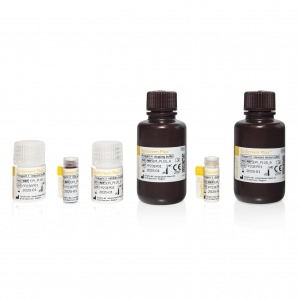Frequently Asked Questions: EpiScreen Plus
FAQ1: Is the EpiScreen Plus method identical to the WHO method?
We have made some significant changes to the product:
- The WHO method uses castanospermine to perform background correction. Castanospermine was replaced by glucose which can be stored at room temperature (versus -20°C) and which has a much greater stability
- Solubility issues with one of the buffers described in the WHO manual have been resolved, again resulting in a very stable and reliable product
FAQ2: Can we measure samples with a spectrophotometer, using cuvettes?
Yes, this is certainly possible but there is one main difference between both setups: One must take into account that the path length of cuvettes (most commonly 1 cm) is larger than that of microtiter plates (usually 0.5 cm). According to the law of Lambert-Beer (Absorbance = extinction coefficient x path length x concentration), the optical density (OD) values will be approximately 2x higher. Therefore, the highest 4-nitro-phenol standards will lie outside of the measuring range of the spectrophotometer. However, based on our experience, linearity of the standard curve can be guaranteed up to 100 µM. This concentration corresponds to a neutral enzyme activity of 47.9 mIU/ml, which abundantly exceeds the cut-off value. If the activity is higher than 47.9 mIU/ml, we advise to dilute and retest the sample.
FAQ3: Can we use a regular incubator for the test?
Samples must be incubated at 37°C to allow optimal enzyme activity. Therefore, we advise to use preferably a heatblock, or a warm water bath, provided that the temperature is guaranteed homogeneous and stable throughout the bath, where samples are in direct contact with the heated environment. A standard cell culture incubator is not suited for this purpose, as heat transfer through the air is slower, which will result in suboptimal reaction conditions.
FAQ4: Do we need to prepare a standard curve with each test?
Yes, a standard curve is necessary with each test.
FAQ5: How do we calculate the alpha-glucosidase value?
We have developed and validated an MS Excel™ template for automatic data processing.
The template is available on the product page or click here to download the excel template for calculation of the results of the EpiScreen Plus kit.
FAQ6: Is measurement at an alternative wavelength possible?
It is recommended to measure at 405nm, no data on other wavelengths is available. If an alternative wavelength is applied, investigate the efficiency before implementing it.
FAQ7: How was the correction factor of 0.479 described in the instructions for use determined?
The correction factor of 0.479 has been established based on the sample dilution factor and incubation time (120 min): The assay uses 20µl of the semen sample, which is diluted in reagents to 1150µl, yielding a dilution factor of 57.5. One enzyme unit is defined as the formation of 1 µmol PNP per minute. Therefore, the dilution factor is divided by 120 to calculate activity per minute. This results in a final factor of 0.479.
FAQ8: Why does the lower limit of EpiScreen Plus (5.88 mIU/ml) differ from the lower limit mentioned in the WHO manual (20 mU/ejaculate) ?
As mentioned in FAQ1, the EpiScreen Plus method slightly differs from the method mentioned in the WHO manual. The cut-off value of EpiScreen Plus has been validated based on ROC analysis data during the design of the kit. Furthermore, we do not recommend to correct for ejaculate volume because this lowers the sensitivity of the test.

